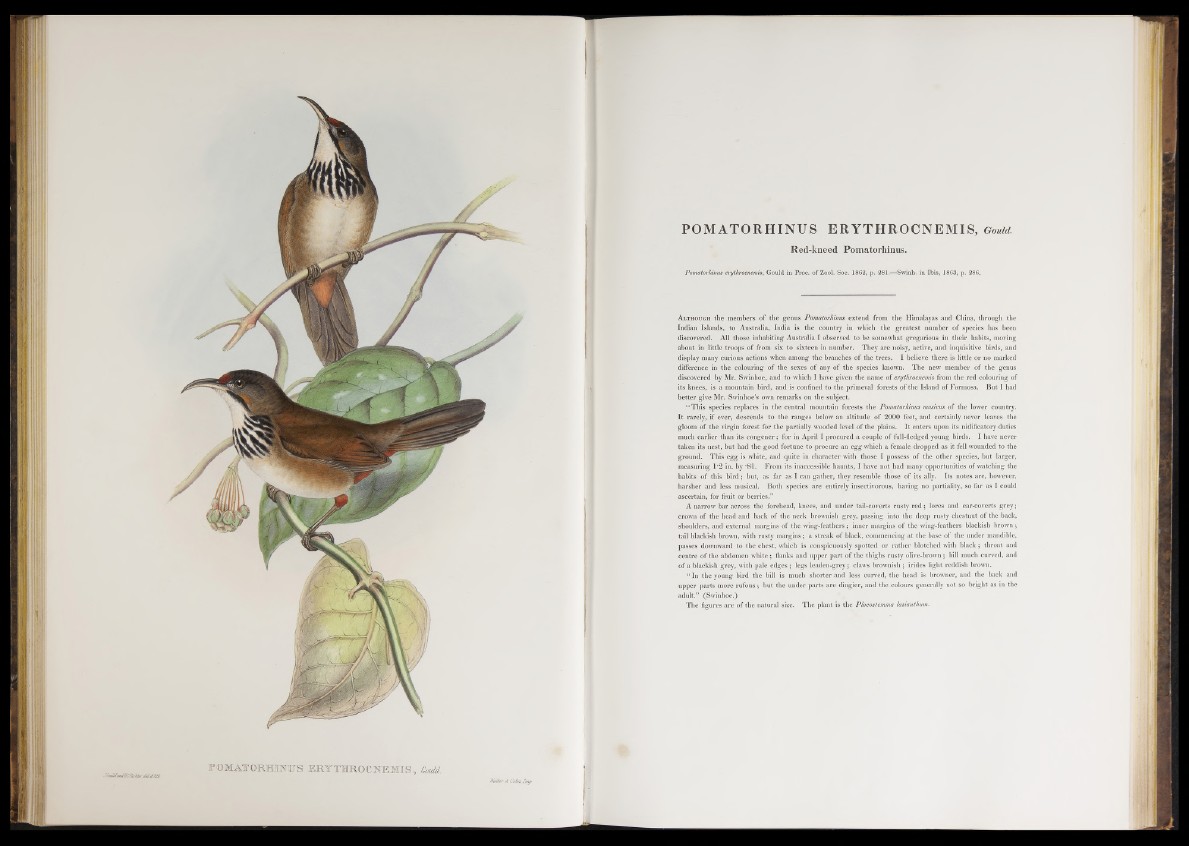
f&ndc/axJtfCJluAier, ¿tislbA POMATORBXNTTS EK Y TH RQ C liEM IS , Gould.
POMATORHINUS ERYTHROCNEMIS, Gould.
Red-kneed Pomatorhinus.
Pomatorhinus erythrocnemis, Gould in Proc. of Zool. Soc. 1862, p. 281.— Swinh. in Ibis, 1863, p. 286.
A l th o u g h the members of the genus Pomatorhinus extend from the Himalayas and China, through the
Indian Islands, to Australia, India is the country in which the greatest number of species has been
discovered. All those inhabiting Australia I observed to be somewhat gregarious in their habits, moving
about in little troops of from six to sixteen in number. They are noisy, active, and inquisitive birds, and
display many curious actions when among the branches of the trees. I believe there is little or no marked
difference in the colouring of the sexes o f any of the species known. The new member of the genus
discovered by Mr. Swinhoe, and to which I have given the name of erythrocnemis from the red colouring of
its knees, is a mountain bird, and is confined to the primeval forests of the Island of Formosa. But I had
better give Mr. Swinhoe’s own remarks on the subject.
“ This species replaces in the central mountain forests the Pomatorhinus musicus of the lower country.
I t rarely, if ever, descends to the ranges below an altitude o f 2000 feet, and certainly never leaves the
gloom of the virgin forest for the partially wooded level of the plains. I t enters upon its nidificatory duties
much earlier than its congener; for in April I procured a couple of full-fledged young birds. I have never
taken its nest, but had the good fortune to procure an egg which a female dropped as it fell wounded to the
ground. This egg is white, and quite in character with those I possess of the other species, but larger,
measuring 1'2 in. by *81. From its inaccessible haunts, I have not had many opportunities of watching the
habits o f this b ird ; but, as far as I can gather, they resemble those of its ally. Its notes are, however,
harsher and less musical. Both species are entirely insectivorous, having no partiality, so far as I could
ascertain, for fruit or berries.’-
A narrow bar across the forehead, knees, and under tail-coverts rusty r e d ; lores and ear-coverts g rey ;
crown of the head and back of the neck brownish grey, pass'ing into the deep rusty chestnut of the back,
shoulders, and external margins o f the wing-feathers; inner margins of the wing-feathers blackish brown ;
tail blackish brown, with rusty margins; a streak of black, commencing at the base of the under mandible,
passes downward to the chest, which is conspicuously spotted or rather blotched with b lack ; throat and
centre of the abdomen white; flanks and upper part of the thighs rusty olive-brown; bill much curved, and
of a blackish grey, with pale edges; legs leaden-grey 5 claws brownish ; irides light reddish brown.
“ In the young bird the bill is much shorter and less curved, the head is browner, and the back and
upper parts more rufous ; but the under parts are dingier, and the colours generally not so bright as in the
adult.” (Swinhoe.)
The figures are of the natural size. The plant is the Plocostemma lasianthum.